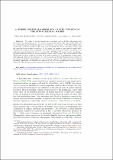A hybrid multiscale model for cancer invasion of the extracellular matrix
Abstract
The ability to locally degrade the extracellular matrix (ECM) and interact with the tumor microenvironment is a key process distinguishing cancer cells from normal cells, and is a critical step in the metastatic spread of the tumor. The invasion of the surrounding tissue involves the coordinated action of the cancer cells, the ECM, the matrix degrading enzymes, and the epithelial-to-mesenchymal transition. In this paper, we present a mathematical model which describes the transition from an epithelial invasion strategy of the epithelial-like cells (ECs) to an individual invasion strategy for the mesenchymal-like cells (MCs). We achieve this by formulating a genuinely multiscale and hybrid system consisting of partial and stochastic differential equations that describe the evolution of the ECs and the MCs while accounting for the transitions between them. This approach allows one to reproduce, in a very natural way, fundamental qualitative features of the current biomedical understanding of cancer invasion that are not easily captured by classical modelling approaches, for example, the invasion of the ECM by self-generated gradients, and the formation of EC invasion islands outside of the main body of the tumor.
Citation
Sfakianakis , N , Madzvamuse , A & Chaplain , M A J 2020 , ' A hybrid multiscale model for cancer invasion of the extracellular matrix ' , Multiscale Modeling and Simulation , vol. 18 , no. 2 , pp. 824–850 . https://doi.org/10.1137/18M1189026
Publication
Multiscale Modeling and Simulation
Status
Peer reviewed
ISSN
1540-3459Type
Journal article
Description
Funding: Partly funded from the German Science Foundation (DFG) under the grant SFB 873: “Maintenance and Differentiation of Stem Cells in Development and Disease” (NS). Partly supported by funding from the European Union Horizon 2020 research and innovation programme under the Marie Sklodowska-Curie grant agreement No 642866, the Commission for Developing Countries; partially supported by a grant from the Simons Foundation (AM). Isaac Newton Institute for Mathematical Sciences for hospitality during the programme [Coupling Geometric PDEs with Physics for Cell Morphology, Motility and Pattern Formation] supported by EPSRC Grant Number EP/K032208/1.Collections
Items in the St Andrews Research Repository are protected by copyright, with all rights reserved, unless otherwise indicated.

